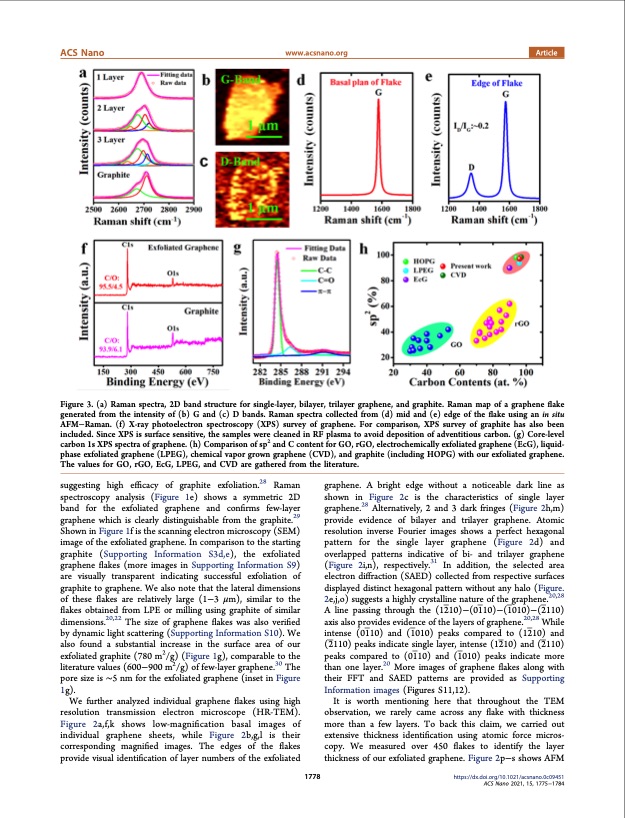PDF Publication Title:
Text from PDF Page: 005
ACS Nano www.acsnano.org Article Figure 3. (a) Raman spectra, 2D band structure for single-layer, bilayer, trilayer graphene, and graphite. Raman map of a graphene flake generated from the intensity of (b) G and (c) D bands. Raman spectra collected from (d) mid and (e) edge of the flake using an in situ AFM−Raman. (f) X-ray photoelectron spectroscopy (XPS) survey of graphene. For comparison, XPS survey of graphite has also been included. Since XPS is surface sensitive, the samples were cleaned in RF plasma to avoid deposition of adventitious carbon. (g) Core-level carbon 1s XPS spectra of graphene. (h) Comparison of sp2 and C content for GO, rGO, electrochemically exfoliated graphene (EcG), liquid- phase exfoliated graphene (LPEG), chemical vapor grown graphene (CVD), and graphite (including HOPG) with our exfoliated graphene. The values for GO, rGO, EcG, LPEG, and CVD are gathered from the literature. suggesting high efficacy of graphite exfoliation.28 Raman spectroscopy analysis (Figure 1e) shows a symmetric 2D band for the exfoliated graphene and confirms few-layer graphene which is clearly distinguishable from the graphite.29 Shown in Figure 1f is the scanning electron microscopy (SEM) image of the exfoliated graphene. In comparison to the starting graphite (Supporting Information S3d,e), the exfoliated graphene flakes (more images in Supporting Information S9) are visually transparent indicating successful exfoliation of graphite to graphene. We also note that the lateral dimensions of these flakes are relatively large (1−3 μm), similar to the flakes obtained from LPE or milling using graphite of similar dimensions.20,22 The size of graphene flakes was also verified by dynamic light scattering (Supporting Information S10). We also found a substantial increase in the surface area of our exfoliated graphite (780 m2/g) (Figure 1g), comparable to the literature values (600−900 m2/g) of few-layer graphene.30 The pore size is ∼5 nm for the exfoliated graphene (inset in Figure 1g). We further analyzed individual graphene flakes using high resolution transmission electron microscope (HR-TEM). Figure 2a,f,k shows low-magnification basal images of individual graphene sheets, while Figure 2b,g,l is their corresponding magnified images. The edges of the flakes provide visual identification of layer numbers of the exfoliated graphene. A bright edge without a noticeable dark line as shown in Figure 2c is the characteristics of single layer graphene.28 Alternatively, 2 and 3 dark fringes (Figure 2h,m) provide evidence of bilayer and trilayer graphene. Atomic resolution inverse Fourier images shows a perfect hexagonal pattern for the single layer graphene (Figure 2d) and overlapped patterns indicative of bi- and trilayer graphene (Figure 2i,n), respectively.31 In addition, the selected area electron diffraction (SAED) collected from respective surfaces displayed distinct hexagonal pattern without any halo (Figure. 2e,j,o) suggests a highly crystalline nature of the graphene.20,28 A line passing through the (12̅10)−(01̅10)−(1̅010)−(2̅110) axis also provides evidence of the layers of graphene.20,28 While intense (01̅10) and (1̅010) peaks compared to (12̅10) and (2̅110) peaks indicate single layer, intense (12̅10) and (2̅110) peaks compared to (01̅10) and (1̅010) peaks indicate more than one layer.20 More images of graphene flakes along with their FFT and SAED patterns are provided as Supporting Information images (Figures S11,12). It is worth mentioning here that throughout the TEM observation, we rarely came across any flake with thickness more than a few layers. To back this claim, we carried out extensive thickness identification using atomic force micros- copy. We measured over 450 flakes to identify the layer thickness of our exfoliated graphene. Figure 2p−s shows AFM https://dx.doi.org/10.1021/acsnano.0c09451 1778 ACS Nano 2021, 15, 1775−1784PDF Image | Production of High Quality Exfoliated Graphene

PDF Search Title:
Production of High Quality Exfoliated GrapheneOriginal File Name Searched:
Ultra-Fast-Chemical-Exfoliated-Graphene.pdfDIY PDF Search: Google It | Yahoo | Bing
Salgenx Redox Flow Battery Technology: Power up your energy storage game with Salgenx Salt Water Battery. With its advanced technology, the flow battery provides reliable, scalable, and sustainable energy storage for utility-scale projects. Upgrade to a Salgenx flow battery today and take control of your energy future.
CONTACT TEL: 608-238-6001 Email: greg@infinityturbine.com (Standard Web Page)